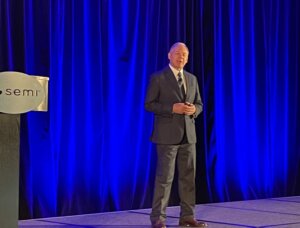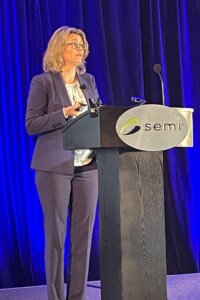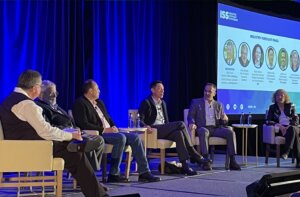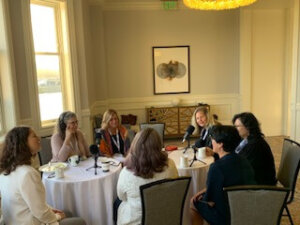Everyone in the semiconductor industry knows that if you want to be where the action is in January, SEMI Industry Strategy Symposium at the Ritz Carlton in Half-Moon Bay is the place to be. Except for this year. This year, thanks to Omicron, we had to wait until April to dive into mission-critical discussions that set our strategies for the year ahead. But it was well worth the wait. For one thing, April in Half Moon Bay is a heck of a lot nicer than January.
Presenters played to a packed house. Women made up 20% of the attendees – an industry first for this event that draws mostly C-suite executives and leadership teams. They also played a more active role than ever, as speakers and moderators, and asking most of the questions from the audience during the sessions. It was the first time in my experience that there was a line in the women’s restroom.
An Industry Redefined

It’s been 27 months since we all came together last, and as Dave Anderson noted in his welcome remarks, in that time we’ve redefined our industry. The digital transformation happened overnight, quite literally, noted AMD’s Mark Papermaster, in his keynote address, and tipped off an avalanche of unintended consequences, many of which framed the topics of discussion for the week. Top of mind was meeting ever-increasing demand amidst an ongoing chip shortage; the impact of the geopolitical situation in China and Taiwan, as well as Russia and Ukraine; the Chips Act, SEMI’s inroads in workforce development, and the importance of diversity, equity, and inclusion; and a growing concern for sustainability efforts.
A Terabuck by 2030

This year’s aggressive call to action is to set in motion strategies that will propel our industry to reach $1T in revenue by 2030. According to Michael Yang, Omdia, that’s double our revenue in 2021 ($587B) in eight short years. And we must do this in the most sustainable way possible if we commit to reaching Net Zero Global Emissions by 2050.
Basically, the demand is there, and that’s driving growth potential, but headwinds could inhibit that growth, noted SEMI’s Inna Skvortsova.
Gartner’s Bob Johnson is also concerned about headwinds. He coined the term “Terabuck” to refer to the trillion-dollar goal. With all that we must accomplish to make it happen by 2030, he says he doubts we’ll make it right on time. But he still urged us to “Think Big! A terabuck will happen in the next 10-12 years,” he said. “The industry will have to find the resources to essentially double in size from 2020.”
Chiplets to the Rescue

“The only way we can service demand is to come together and drive compute capabilities going forward,” said Papermaster. He said that while AMD is committed to a 30% improvement in computing process capabilities, energy consumption is a huge challenge. Global dependency on semiconductor devices is phenomenal and high-performance packaging is the answer – 2D chiplets, 2.5D interposer, and 3D chiplets.
Explaining chiplet architectures to a front-end audience, Jan Vardaman, of Techsearch International said the industry needs a new approach to achieve the economics that we previously achieved with scaling and predicted that chiplets are ushering in a new era of semiconductor packaging that will be a key enabler for the next 10-20 years. “The chiplet is not the package. It’s the design philosophy,” noted Vardaman. “We’re changing our thinking from being silicon-centric to design.” She added that there will be no one single chiplet package, but rather, lots of different options. Mark Papermaster and Intel’s Ann Kelleher proved that through their presentations, presenting all the architectures AMD and Intel have in the works.
Creating a Risk-Ready Supply Chain
For me, the presentation that was the most compelling of the week, so much so that we’re dedicating a podcast episode to it, was delivered by Bindiya Vakil, Founder, and CEO of Resilinc, on creating a risk-ready semiconductor supply chain.
As we all know, events of the last two years that are beyond our control have had a significant impact on the semiconductor supply chain, sending us scrambling for workarounds and playing catch-up. What if we had been better prepared to proactively address these issues? That’s where mapping and real-time monitoring of potential disruption comes in. Vakil compared the industry’s response to the over 200 hundred weekly disruptive events that hit our supply chain with Whack-a-Mole. We need to shift from a reactive to a proactive, predictive approach if we are to have a successful supply chain, she says.
“We can grow if we can deliver, if we can’t deliver, we won’t grow,” she said. “The supply chain is showing us that it has failed. If we don’t address supply chain issues that are inherent, it will be a key obstacle in our ability to achieve growth projections.” In this case, a terabuck by 2030.
Vakil’s solution is? Using mapping techniques combined with real-time monitoring of potential disruption. “Mapping and monitoring allow you to proactively outline the worst-case situations, collaborate with your suppliers, take deliberate action and protect knowns based on available information,” she explained.
She said the way companies currently handle procurement is a problem. “We have to collaborate with suppliers instead of fighting over cost savings,” she said. “A rising tide lifts all ships. We need to make risk a priority and focus on designing a supply chain for the future.”
What does that look like? Vakil says rather than each country trying to go it alone, we should focus on “re-globalization.” It’s critical to collaborate with partners close by to make global supply chains resilient, sustainable, fair, and secure.
Tensions in China and Taiwan
Speaking of planning ahead, Blazek’s presentation on China-Taiwan relations. Blazek is an Asia Pacific Analyst at Stratfor – A RANE Company. He uses a scenario-building approach to explain how growing tensions between China and Taiwan could potentially impact semiconductors by applying the likelihood percentages of each scenario.
Blazek explained that Xi Jinping sees himself as a historical leader and wants to do something about Taiwan before he steps down. He said that Taiwan matters for global shipping lanes and that Japan and Australia have the most to lose if Taiwan loses its independence. Because a growing minority of Taiwanese want independence, prospects for peaceful reunification is slimming, noted Blazek.
However, because of China’s dependence on Taiwan for chips, we are unlikely to see a war there in the next five years. Additionally, after seeing the response of the world to the Russian invasion in Ukraine, China is realizing it would end up being more isolated than ever. Still, Blazek says chip reliance on Taiwan will eventually be a problem, which is driving countries to put backup plans in place.
The Ukraine War’s Impact on Rare Gasses
At the macroeconomic level, Tim Mahedy, Senior Economist, KPMG US, downplayed concern for the impact of the war in Ukraine on the global economy and was more concerned about the real-estate situation in China.
He pointed out that US linkages to Russia are not strong, and they’ve never been a major trading partner, and even less so since Russia annexed Crimea. At most, the war in Ukraine caused a surge in some commodity prices. “Lockdowns are easing. Even with what’s going on in China, the global economy is starting to heal… we’ve had a hiccup with the Ukraine War, but we’re continuing to progress.”
Hiccup? Really? Tell that to attendee Kristian Yurygin, Chief Commercial Officer of Recycling Solutions, Ukraine. Yerygin attended ISS representing Arnox, a strategic waste and byproduct management company that is part of a Ukrainian steel conglomerate, and a producer of Neon, Xenon, and Krypton. These rare gasses are critical for lithography processes used in semiconductor manufacturing.
I had the opportunity to interview Yerygin for the 3D InCites podcast. He explains in detail the impact of the Russian invasion of Ukraine, the toll it’s taking on the steel industry, and subsequently the supply of Neon, Xenon, and Krypton. He explains what it could mean for the semiconductor industry and what semiconductor manufacturers need to do to prepare for an inevitable shortage of these rare gasses.
Summing it Up
As you can see, while the demand for semiconductor devices is there to reach a terebuck in revenue by 2030, there are a lot of challenges we’ll need to overcome to get there. If we don’t make it on time, does it matter? Not really. The point is, the potential is there, and we’ll get there at some point.

ISS 2022 Series on the 3D InCites Podcast
Despite its length, this blog post barely scratches the surface of what was discussed at SEMI ISS 2022. We’ll be running a six-episode podcast series over the next few weeks. The episodes will be available here as they become available, so be sure to bookmark this page, or better yet, follow the 3D InCites Podcast on Apple podcasts, Spotify, IHeart Radio, or wherever you get your podcasts.



















